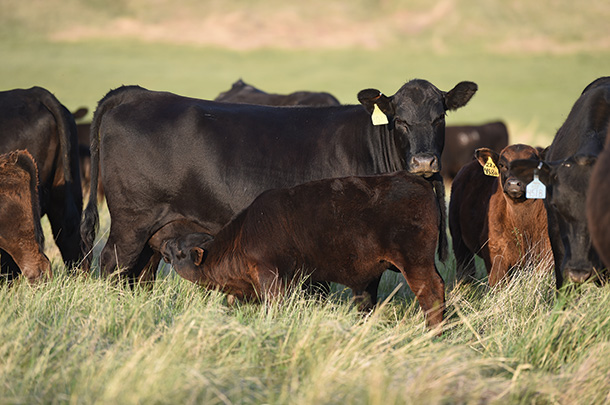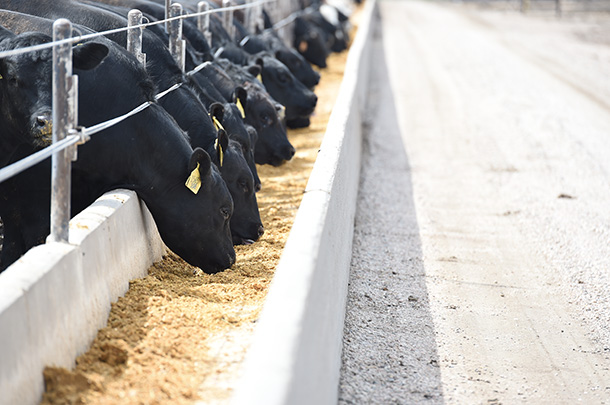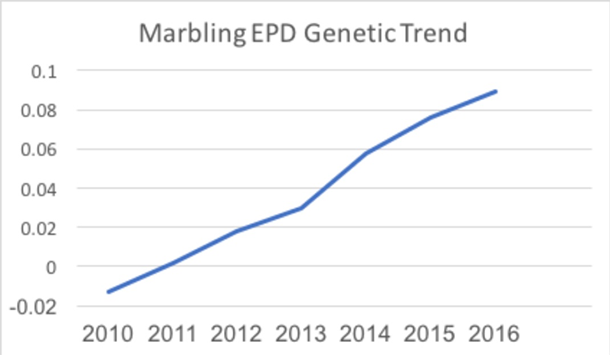On the Ranch
The number one factor that impacts profitability on the ranch, is the fertility of the cow. Without a calf each year, that cow costs the rancher money. The Gelbvieh cow is a solution to that problem. Fertility is one of the most valued traits in the Gelbvieh cow. When commercial Gelbvieh and Balancer producers are talking about their cowherd and why they stay with those genetics, a large majority of producers cite exceptional cowherd fertility as a standout trait.
Gelbvieh cows are also known for their stayability. Stayability refers to the reproductive longevity of a cow. Gelbvieh cows breed back year after year and wean off a good size calf.

Another major factor that impacts a commercial producers bottom line is the efficiency of the cow. The Gelbvieh cow is known for her moderate mature size weaning off heavy calves. Gelbvieh ranks number 1 for smallest mature cow size and are the earliest to mature of the seven major beef breeds according to U.S. Meat Animal Research Center.
More and more producers are looking for replacement females that have Gelbvieh genetics because of the maternal advantages. Kurt Johnson, cow-calf producer from north central Nebraska ranks maternal ability, fertility, and longevity as extremely important traits. After Johnson sorts off his favorite heifers for replacements, he markets the remaining heifers as feeders at the local sale barn, but most of those heifers are bought as replacements by other commercial producers.
The females in Johnson’s herd raise fast growing calves that, once weaned, are ready to go to the feedyard and convert feed to beef.
In the Feedyard
Improve the feeding performance of your cattle by utilizing Gelbvieh and Balancer genetics in a crossbreeding program. Crossbreeding with Gelbvieh and Balancer can increase the rate of gain, and improve feed conversion.
Gelbvieh-influenced cattle excel at weaning weight, and at post-weaning growth as well. Gelbvieh and Balancer cattle perform very well in the feedyard.

Producers who have retained ownership of their cattle through the finishing phase, often report average daily gains of 3.5 pounds/head/day, or even higher. Feedlot operators who have purchased Gelbvieh and Balancer-influenced feeder cattle have also experienced similar performance.
“The Gelbvieh and Balancer bulls have improved the consistency and uniformity of our calves. We like the growth, performance, and disposition of the Balancer calves, according to Adam Sindt, R&J Farms from Nebraska and 2017 AGA Commercial Producer of the Year.
Steers in the 2017 AGA Scale and Rail contest had an average daily gain of 4 pounds/head/day in the feedyard.
Feed efficiency is a major profit driver in beef cattle production and, especially in the cattle feeding/finishing sector. Gelbvieh-influenced cattle excel in the area of feed conversion. Decreasing the amount of feed needed to produce more pounds of saleable product increases your profit potential.
“Gelbvieh-influenced cattle provide added carcass weight. At the end of the day we’re still paid on pounds. They also add ribeye, more gaining ability, and feed efficiency. All things that are highly valuable,” said Bill Tucker, Tucker Family Farms, Amherst, Virginia.
On the Rail
Not only do Gelbvieh and Balancer cattle perform well in the feedyard with increased efficiency and growth, Balancer cattle make the grade and deliver the value on the rail.
Many feeders have reported Balancer-sired cattle that grade 90 percent Choice or better. In today’s marketplace where higher quality grades yield a premium, Gelbvieh and Balancer-influenced cattle meet those modern industry demands.
In addition to quality grade, Gelbvieh and Balancer-influenced cattle have been proven to excel in percent retail product. According to the U.S. Meat Animal Research Center progress report #22, Gelbvieh rank #1 for percent retail product.
In 2016, the American Gelbvieh Foundation launched its first annual Steer Challenge and Scale and Rail Sire-Identified Carcass Contest, which helps to provide information necessary to advance Gelbvieh and Balancer carcass merit. A total of 103 head participated in the 2017 contest and all head were harvested in July 2017. These cattle graded 85 percent Choice or better, with 91 percent of the cattle finishing Yield Grade 1, 2, or 3. These cattle also had an average dressing percentage of 64.42 percent.
The AGA is committed to continually strengthening Gelbvieh and Balancer carcass value on the rail by providing producers with FPI™, which stands for feeder profit index. FPI aids producers in selecting sires whose progeny will perform in the feedyard and are sold on a grade and yield standpoint. Well ranking sires for FPI have higher marbling and carcass weight than their contemporaries. The average FPI over the last 20 years has increased within the Gelbvieh and Balancer breed by $19.14, proving Gelbvieh and Balancer cattle are meeting modern industry demands.
On the Plate
The 2016 Beef Quality Audit published by National Cattlemen’s Beef Association stated that “many companies were willing to pay a premium for guaranteed quality … Tenderness and flavor continue to be the two beef quality factors that drive customer satisfaction.”

Gelbvieh and Balancer producers are committed to improving the carcass genetics of the breed with each calf crop to produce a tasty, satisfying eating experience for the consumer. Since 2010, the genetic trend for marbling has been steadily increasing.
Source: American Gelbvieh Association







